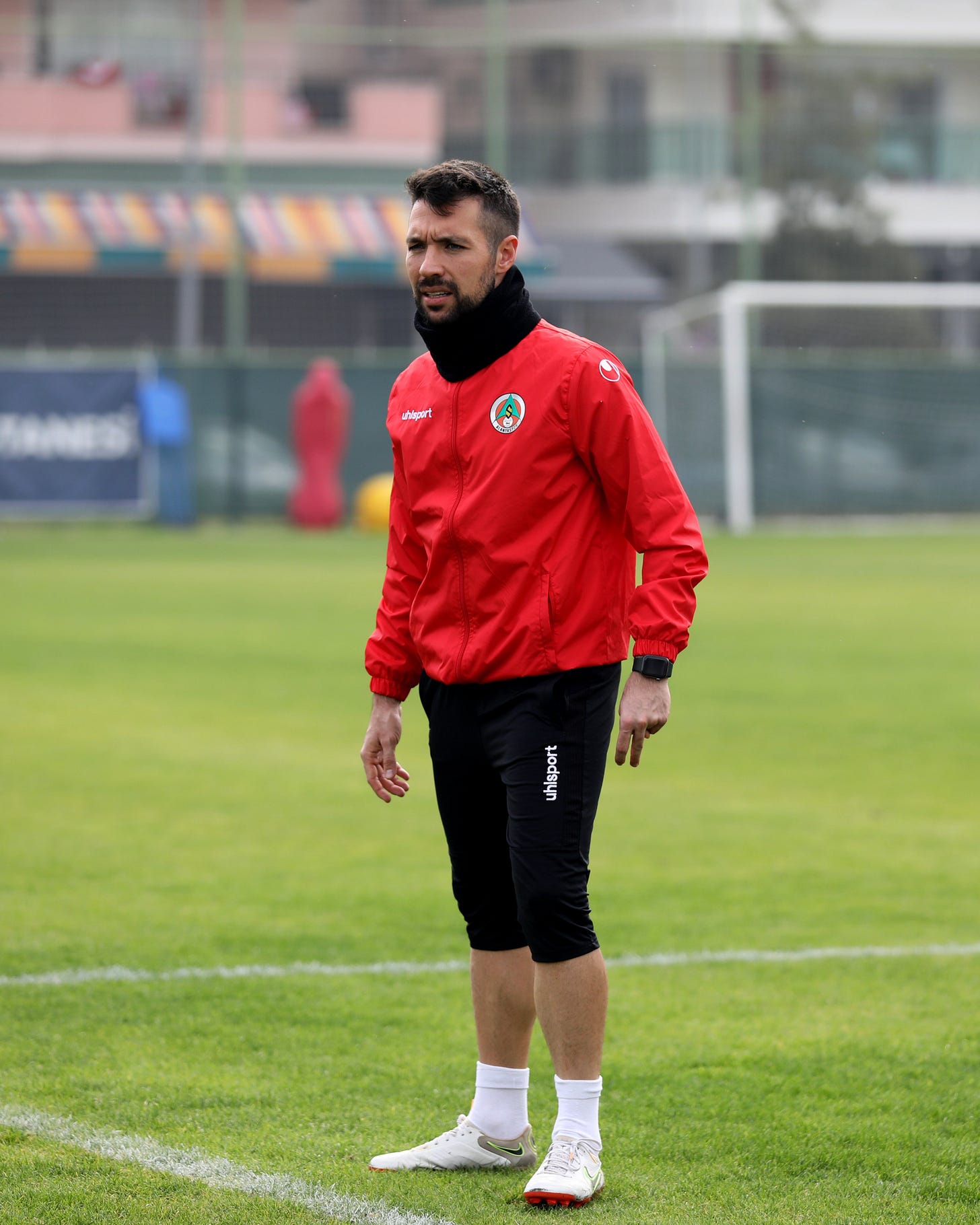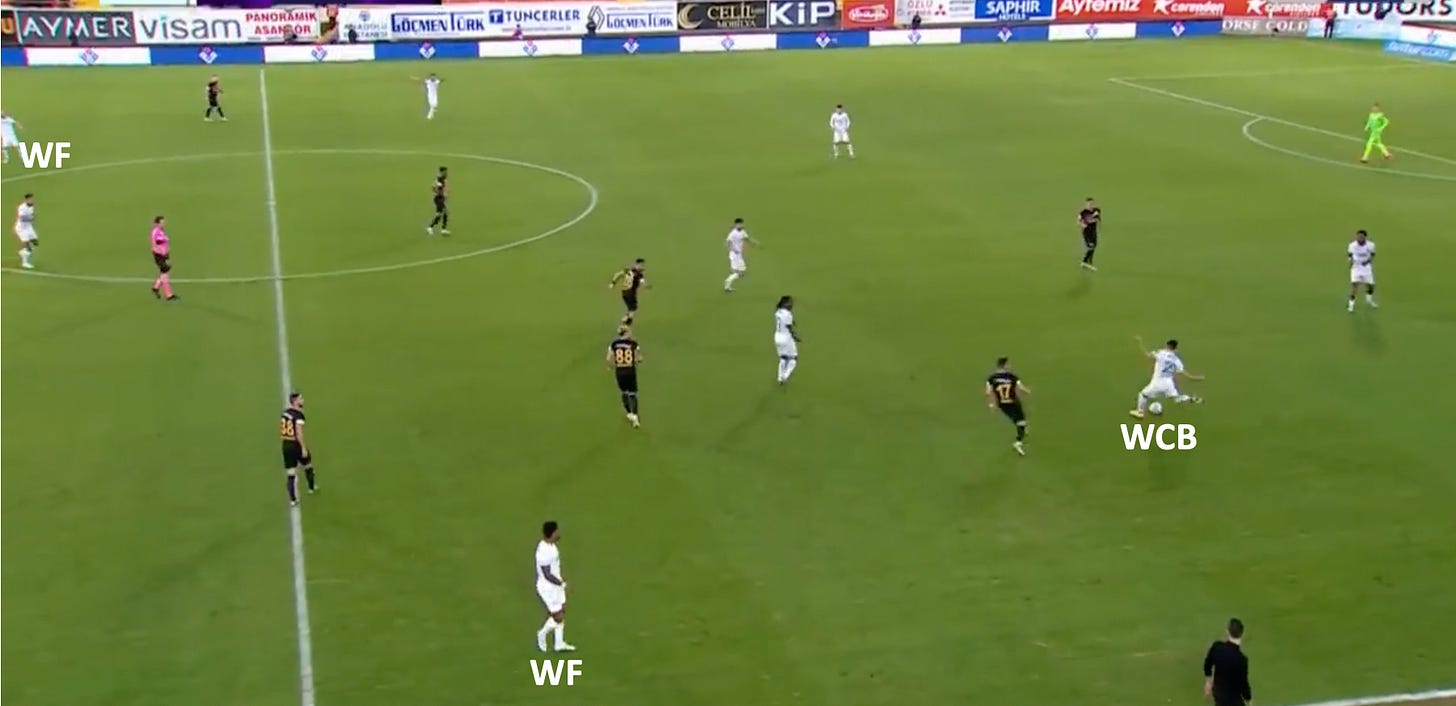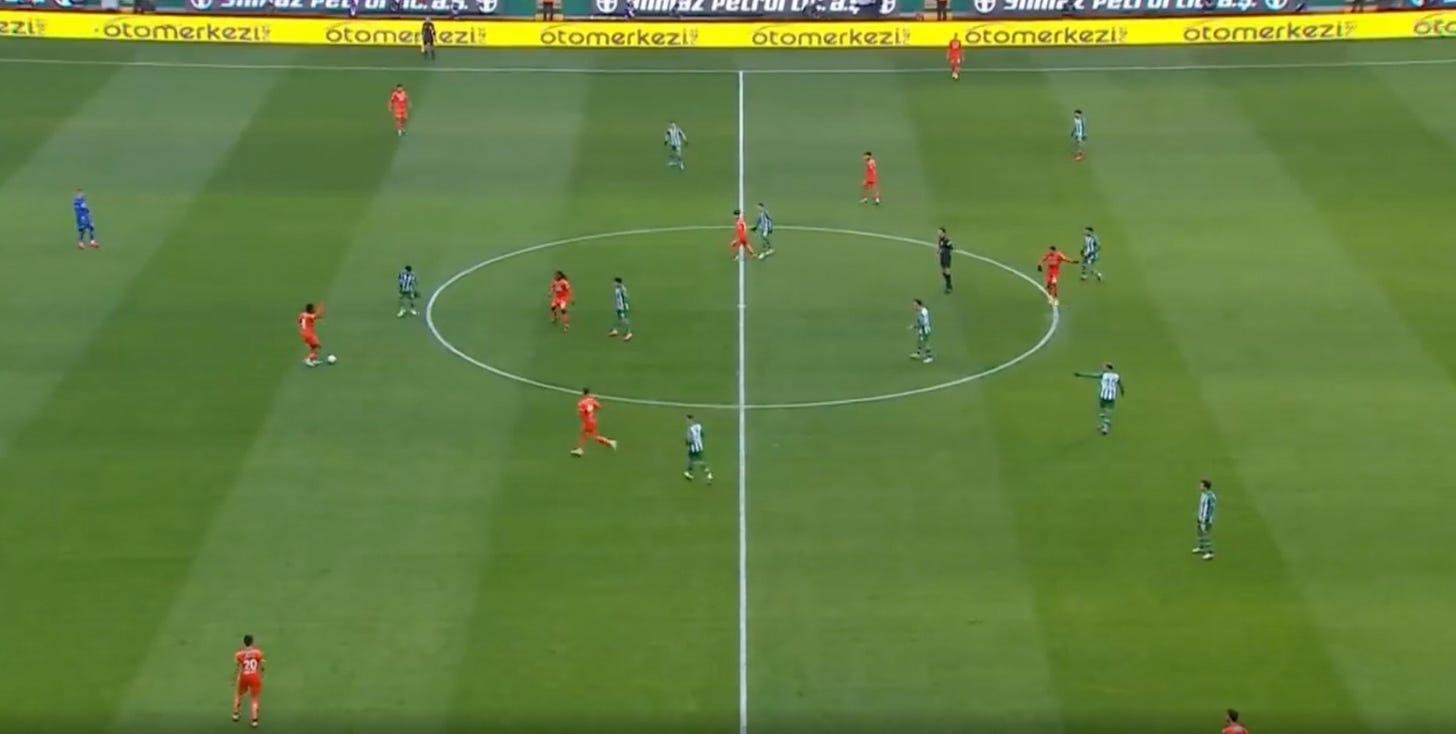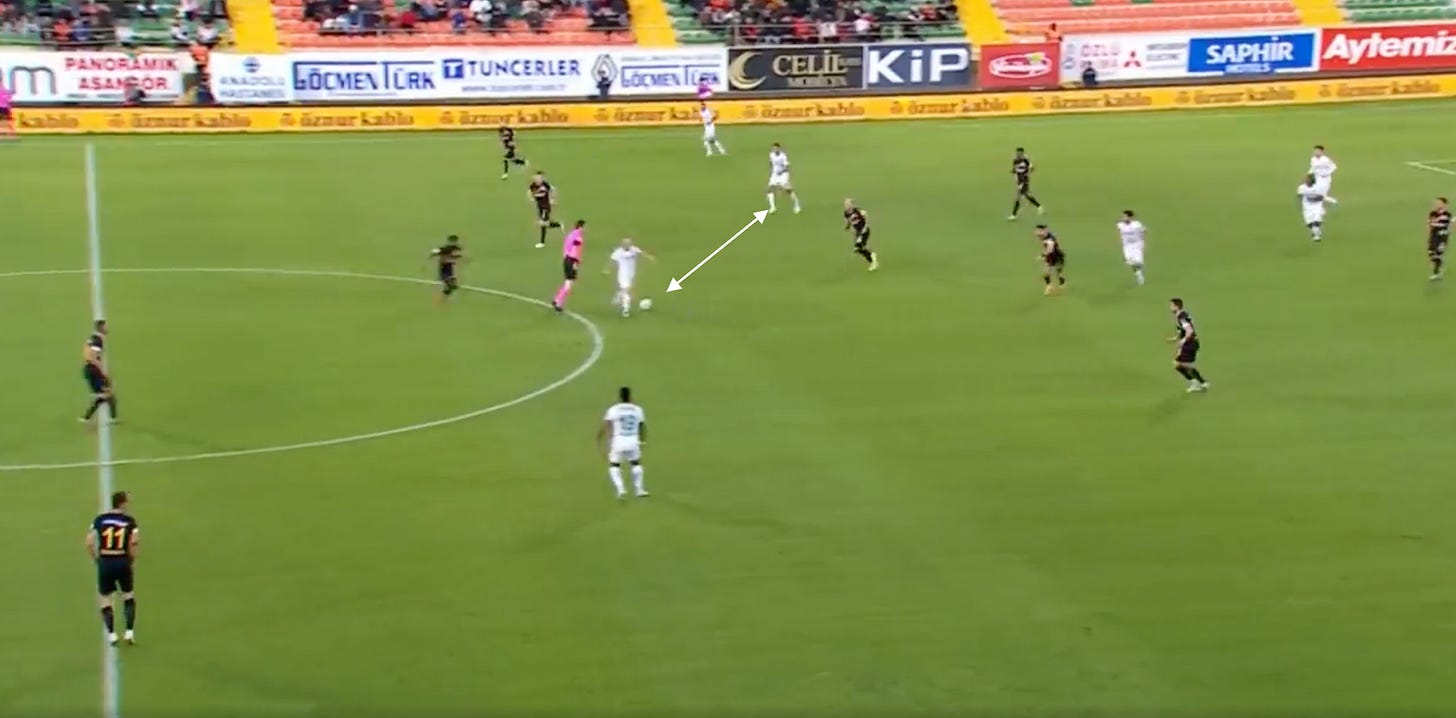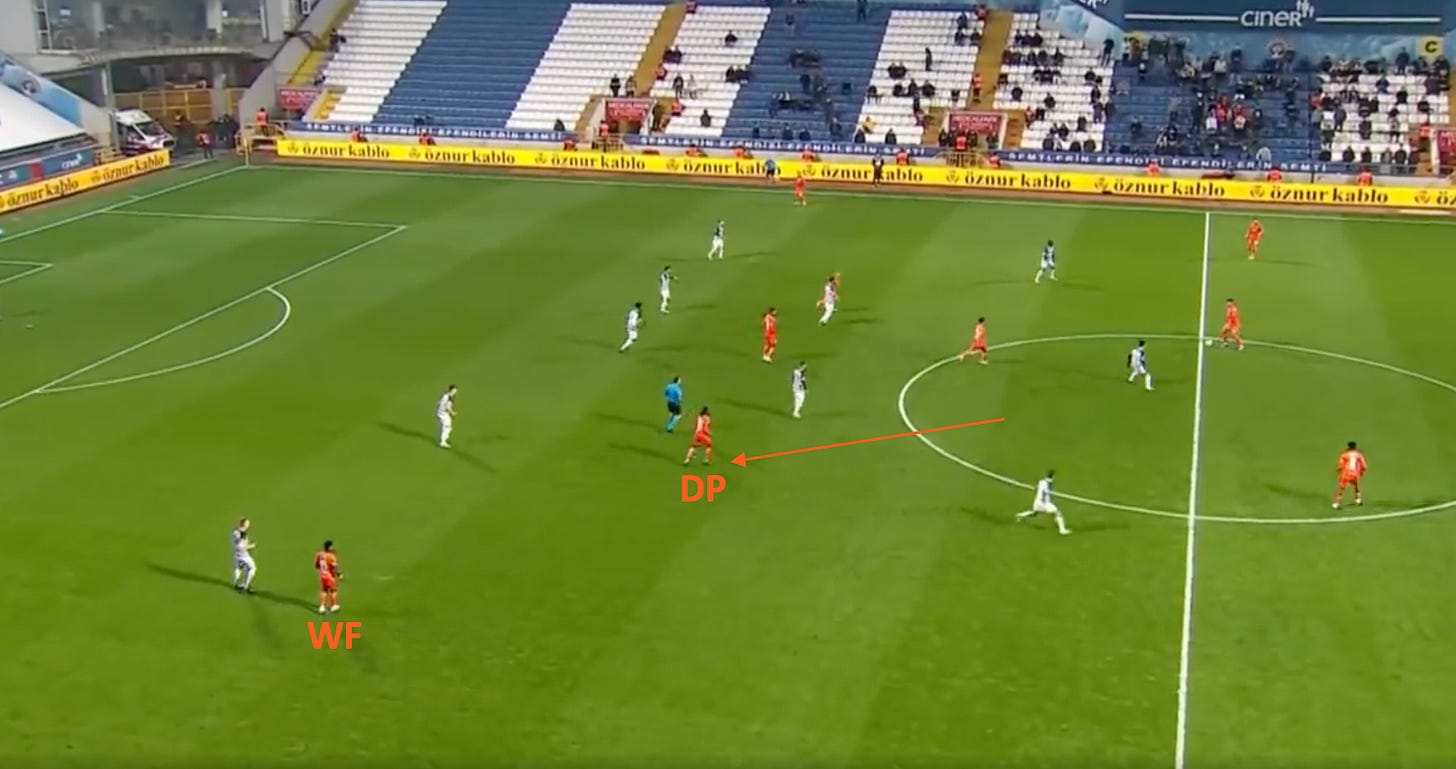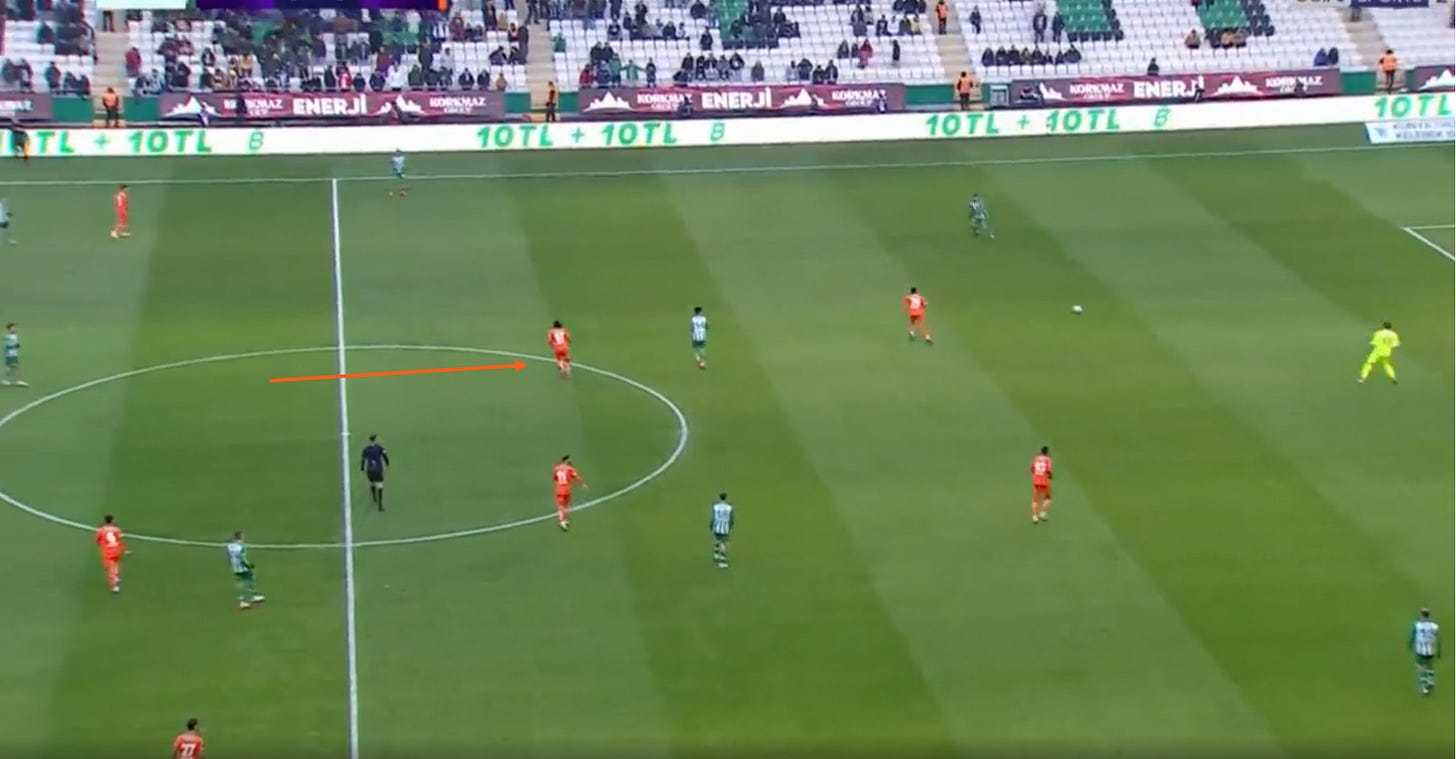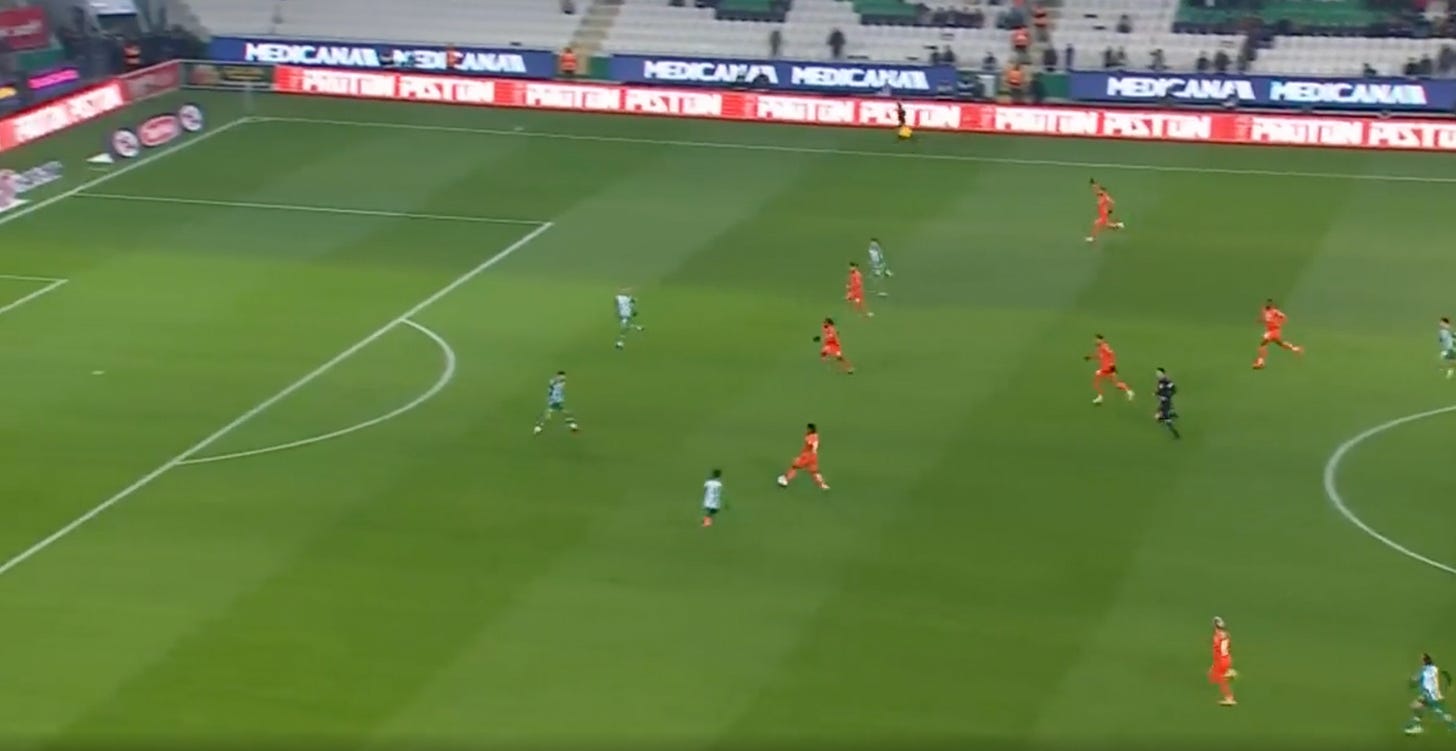Tactical Analysis: Francesco Farioli's Alanyaspor
After he was a key part of Roberto de Zerbi’s backroom staff in Italy at Benevento and then Sassuolo, Franceso Farioli left to become the assistant manager at Alanyaspor for the 2020/21 season. In March of 2021, Farioli took his first foray into management with a brief but promising spell at Fatih Karagümrük, before returning to Alanyaspor in December, this time as head coach.
At just 33 years of age, the Süper Lig’s youngest manager has turned heads with his exciting and bold style of play, which helped Alanyaspor to their record points tally last season, missing out on European qualification by just one point.
This analysis will examine Farioli’s tactical approach at Alanyaspor, with an emphasis on their offensive organisation. To stay as relevant as possible, I will focus on Alanyaspor’s tactical setup since the World Cup break ended.
Line-ups and formation
Since club football has resumed, Farioli has exclusively started matches in a 3-4-3 starting formation.
The only nailed on starters are Hassan at centre forward, and the midfield pair of Lusumba and Güneş. Aksoy and Bayir also start most matches, both of whom can play on both sides of a back three. Ozdemir is the only natural left wingback, with the likes of Pereira and Ferhat featuring on both sides.
I’ll be referring to positions in this 3-4-3 with the following abbreviations in images:
CF - centre forward
WF - wide forward
WB - wingback
DP - double pivot player
WCB - wide centre back
CCB - central centre back
GK - goalkeeper
The wide forwards could be referred to as attacking midfielders, but the difference is semantic and I think the term wide forward better reflects their flexible roles.
It’s also worth noting that Alanyaspor can switch to 4-3-3, with midfielders pushing up into the half-spaces and wide forwards holding the width. However, this article will focus on Alanyaspor’s tactical setup starting from a 3-4-3.
Offensive Organisation
Alanyaspor look to draw in their opponents during deep build-up in an extremely provocative manner. Their goalkeeper Runarsson will split the centre backs by stepping into the first line, with the wide centre backs taking up narrow fullback positions, creating a back four. Their double pivot will also be positioned very deep, sometimes receiving the ball inside of the 18-yard box. This creates a 4-2 structure, which almost always creates a numerical superiority against the opponent’s first line. The wingbacks will push high and wide, while the centre forward will pin the centre backs. The wide forwards have the most flexible role, and their positioning can make Alanyaspor’s shape look like a 4-2-5, a 4-box-3, or something in between.
The numbers we assign to these shapes don’t really matter, what matters is the movements that make them and the options and threats that they create. The end goal of this approach is to pin the opponent’s defensive line back at the same time the opponent’s midfield is being drawn forward. This creates space in between the midfield and defensive lines, where Alanyaspor’s wide forwards can look to operate. In the image shown below, we can see an example of Alanyaspor’s double pivot drawing the opponent’s midfield up the pitch, creating space in between the lines.
One of the most important aspects of this build-up structure is the positioning of the double pivot. With them in such a deep position and in such close proximity to the centre backs, it forces the opponent’s midfielders into a decision. Either let them receive the ball behind the first line uncontested or commit to following them. The disadvantages of the first approach go without saying, but if the opposing midfield takes the bait it puts Alanyaspor in a great position, as we can see in the example below.
Playing against Konyaspor’s 4-1-4-1 defensive shape, Alanyaspor’s double pivot has pulled Konyaspor’s two 8s high up the pitch. Despite this, Alanyaspor still have a numerical advantage in the first phase of build-up with a 6v5, leaving a 5v5 against Konyaspor’s back four and defensive midfielder. Both centre backs are pinned by the centre forward, and their fullbacks are pinned by the high and wide wingbacks, leaving Konyaspor’s defensive midfielder completely stranded in a 2v1 between the lines. With an overloaded first line, Konyaspor struggle to prevent Runarsson from finding enough time and space to find a pass to one of the wide forwards.
If Alanyaspor can bypass their opponent’s front and midfield lines, it leaves them with a dangerous offensive situation on their opponent’s backline which can resemble a counter attacking situation due to the number of players the opponent has committed upfield. We can see an example of one of these ‘false transitions’ in the example shown below. Alanyaspor have played out of Trabzonspor’s press, leaving them with a 5v4 on the last line, a situation which (in settled play) is a rarity for teams playing more traditional styles. Once in these situations, the players have much more freedom to find their own solutions.

Alanyaspor use asymmetry while attacking to cause problems for their opponent. One of the most common examples of this is having one of the wide centre backs take up an inverted position during build-up, giving him passing angles that would normally be unavailable.
Another example of asymmetry in Alanyaspor’s offensive approach involves the wide forwards, a common pattern is the wide forward on the ball side dropping into space in between the lines, while the far side wide forward will push up on the defensive line. This can either pin defenders or threaten with a run in behind. We can see an example of this in the image shown below. The wide forward on the ball side drops to provide an option, while the far side wide forward pushes onto the defensive line. The first image shows the inverted wide centre back on the ball, with the differing wide forward movements, Karaca is on the far side pinning defenders, while Cavaleiro on the near side drops to provide a safer passing option. The second image shows another example of the far side wide forward being more advanced, this time making a run into the space behind the defensive line.
As previously mentioned, the numbers we give to these structures don’t matter that much. It is probably more accurate to separate Alanyaspor’s offensive structure into four lines with differing roles as explained below, rather than calling it a 4-2-5 or otherwise.
1st line - Goalkeeper and centre backs -Draw in the opponent’s forward line.
2nd line - Midfield double pivot - Draw in the opponent’s midfielders to create separation between the opponent’s midfield and defensive lines, receive in behind the opponent’s first line of press.
3rd line - Wide forwards - Look to receive in between the lines, pin the opposing defenders, or threaten space in behind the opponent’s defensive line.
4th line - Centre forward and wingbacks - Pin the backline and threaten the space in behind the opponent’s defensive line.
Alanyaspor can access all four lines during build-up, especially when Runarsson is on the ball. He has the ball-playing ability to be able to break lines with his passing or find a runner in behind with a ball over the top, especially on the far side. This gives them an element of unpredictability and flexibility in attack, and it forces their opponent to defend the entire pitch at once. The video below shows this in action, Kayserispor allow Runarsson time and space on the ball and the Iceland international finds a perfect pass over the top for a far-side run from the left wingback Özdemir.
Kayserispor may look like they’ve defended this situation badly, but they were always in a lose-lose scenario. By not putting pressure on the ball carrier, they allowed Alanyaspor to threaten the space in behind. If they did put pressure on the ball carrier, it would risk allowing Alanyaspor to play out from the press and threaten the space in between the lines by dragging their players even further out of position. Either way, Alanyaspor are in a favourable situation due to their use of the goalkeeper in the first line.
Once they’ve progressed far enough up the pitch and using the goalkeeper in the first line is no longer a practical option, Alanyaspor still look to create similar advantages with 10 players as opposed to 11, though Runarsson will still look to provide a safety pass once build-up has reached a higher position.
Another way Alanyaspor can threaten their opponent is with rotations, especially using their wide forwards. At times they will swap positions with one of the double pivot players, especially on the right side. This confuses markers and can create space for the pivot player to run into or space in the midfield for the wide forward to receive. These rotations are more common when Bekiroğlu or Karaca are one of the wide forwards, as they have the skillset to operate in deeper positions as well. Bekiroğlu in particular has been used as a wide forward and in a double pivot. We can see some examples of this rotation between the wide forward and the pivot player below.
Another movement involving the wide forwards that Alanyaspor use is having the centre forward drop into a deeper position, while the wide forward makes a run into the space that has been created. We can see examples of this below.
These counter movements are especially useful when Runarsson is on the ball, as he usually has the time and space to pick out either option, whether it be the player dropping between the lines or the run in behind the defence.
Besides these rotations and movements, Alanyaspor players will swap places if needed in order to keep the basic structure of a front five of players occupying the the full width of the pitch, as well as in both half-spaces and the centre. We can see examples of this below. In the first one, the wide forward and centre forward have swapped in order to occupy all five zones. In the second example the wingback and the wide forward have swapped to ensure that the full width of the pitch is being utilised.
The double pivot players will sometimes push up to occupy space in between the lines. This is more common when playing against a conservative double pivot, as it can create a 3v2 in between the lines against opponents that try to stay compact in those areas. We can see an example of this in the image below, where the double pivot player has moved in between the lines to create a 3v2. Notice how the wide forward has shifted to a much wider position in order to maintain full width of the pitch and not occupy the same zone with two players.
Another common movement I’ve noticed from the double pivot players is horizontal decoy runs when one of the first line players is on the ball. By running across the ball carrier, the pivot player can drag a marker out of position and open up the passing lane into the wide forward.
We can see an example of this below.
Defensive Organisation
Defensively, Alanyaspor set up in a 3-4-1-2 or 3-4-2-1 depending on their opponent’s shape. They go man-to-man in central areas with the first priority being to prevent the opposing pivot players from receiving the ball. To do this one or both of the wide forwards will drop back to mark the deepest opposing midfielder(s) while the other players will look to shepherd the ball into wide areas. Once the ball is forced to a deep fullback or wide centre back, the wingback on that side will jump to press as the ball is played. We can see this pressing structure in the examples shown below.
If needed, Alanyaspor’s wide centre back on the near side will shift wider and act as a fullback to prevent the opposing wide forward from receiving behind the pressing wingback. This can create a situational 4-2-3-1 defensive shape when the wingback pushes up while the wide centre back acts as a fullback. This can create gaps in the backline, which will be filled by one of the double pivot players if the opponent’s look to threaten this space with a run. We can see an example of this in the image below.
This points to Alanyaspor’s biggest defensive weakness in settled play which is, in my opinion, the role of the double pivot. As previously mentioned, they will usually go man-to-man on the opponent’s advanced midfielders. However, they are susceptible to being dragged out of position, which can be due to their pressing responsibilities, their man orientation, or because at times one of the double pivot players will leave their man to mark a deeper opposing midfielder.
If the pivot player is out of position, it becomes the responsibility of the wide centre back on that side to plug the gap in between the lines. This can cause vulnerabilities, especially during pressing moments as the wingback on that side now has more defensive responsibility and would need to track back to defend the space, rather than being in their usual higher position to press. We can see an example of this pattern in the image shown below.
In the next image, we can see another example of the pivot player being drawn out. This time he is simply following his man into a deeper position, but it leaves a player in between the lines for the wide centre back to deal with.
This is indicative of Alanyaspor’s first priority when pressing, which is to prevent the opponent’s deeper midfield player(s) from receiving behind the first line, even if it means temporarily disrupting the defensive shape or passing the responsibility for covering the space in between the lines to the centre back.
Transitions
When they win the ball, Alanyaspor will look to break quickly if they can immediately threaten the opponent’s goal. They will commit more players forward during an offensive transition than a false transition stemming from build-up as we can see in the example below. The front three, both wingbacks, and the double pivot are all supporting the attack, leaving just the back three behind.
If they win the ball closer to their own goal, Alanyaspor are more likely to recycle possession, as they know they can create a better ‘transition’ moment by simply drawing in the press rather than immediately trying to attack.
When it comes to defensive transitions, losing the ball during one of their deep build-up moments is where Alanyaspor are at their most vulnerable. With the wide centre backs so far from the centre it leaves just one centre back in position to deal with immediate threats to the box. We can see an example of one of these deep transitions in the image below, Alanyaspor lose the ball during build-up and concede a goal. We can see how wide the highlighted wide centre backs are, which allows space in the centre if the double pivot cannot cover in time.
Alanyaspor’s defensive transitions in midfield areas are much more solid. With a double pivot and wide forwards at times creating a box in the midfield, it allows them to pack the centre and quickly regain the ball once it’s been lost. In the example shown below, Alayaspor look to play direct to the wide forward from build-up but the aerial duel is lost. The resulting transition is won due to the packed centre, with both wide forwards in deeper and central positions. The wingback on the far side can also be useful as they can be found in more central positions when making runs in behind the defensive line and their subsequent positioning can allow them to aid in central areas if the ball is lost.
Losing the ball in the opponent’s final third is another area where Alanyaspor can be exposed, with the biggest weakness being their high and wide wingbacks. If they lose the ball high up the pitch the wingbacks, (especially the one on the far side) struggle to get back in time and it’s usually just the back three and one or both of the double pivot players who are in position to defend immediately after possession is lost. Below we can see an example of one of these situation. Alanyaspor have lost the ball and one of each of their wingbacks, double pivot, and centre backs are out of position. This leaves just a handful of backtracking players to defend the transition, with nobody on the far side as the wingback has been caught high and wide.
Conclusion
Alanyaspor have been one of my favourite teams to watch this season. They play exciting and bold football, with a really interesting tactical style that not many teams can replicate. It’s clear to see De Zerbi’s influence on Farioli’s footballing philosophy, however he has his own methods and I intentionally avoided comparing the two in this article. Either way it makes for a fascinating watch. I hope this analysis has shed some light on how Alanyaspor play, and I wish Francesco and his team all the best for the rest of the season.



